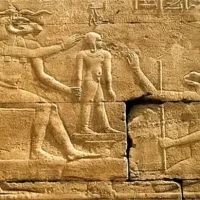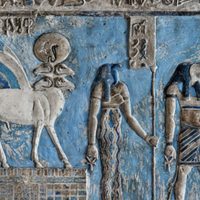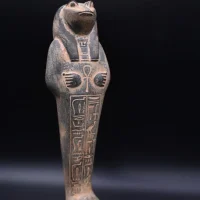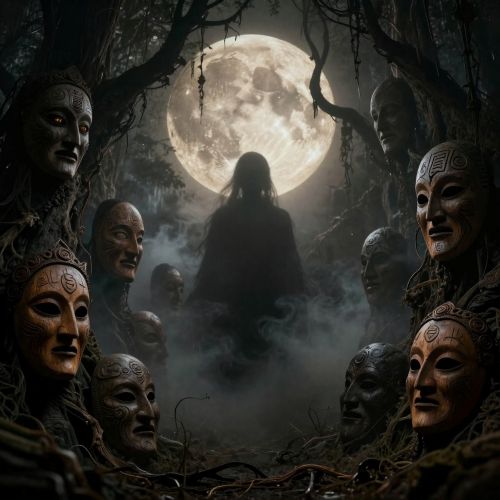Sabazios : The Sky God
Listen
At a glance
| Description | |
|---|---|
| Origin | Phrygian Mythology |
| Classification | Gods |
| Family Members | N/A |
| Region | Turkey |
| Associated With | Sky, Horses |
Sabazios
Introduction
Sabazios, also known as Sabazius or Sabadios, was a revered deity of the Phrygian and Thracian pantheons, often associated with the sky, fertility, and divine kingship. His cult spread widely from ancient Anatolia through Thrace and into Greece and Rome, where he became a syncretic figure identified with gods such as Zeus, Dionysus, and Jupiter. Typically portrayed as a mounted god riding a powerful steed, Sabazios symbolized the union of heaven and earth, reflecting both celestial authority and agricultural prosperity. Archaeological and literary evidence reveal that his worship involved elaborate mystery rites, ecstatic ceremonies, and the use of symbolic bronze hands that served as votive offerings. Despite the decline of his cult by late antiquity, Sabazios remains an intriguing figure in ancient religion, embodying the fusion of Indo-European sky worship with Anatolian and Hellenistic traditions.
Physical Traits
In ancient art and sculpture, Sabazios is consistently depicted as a horseman deity, often bearded and regal in appearance. He is usually shown raising his right hand in a gesture of blessing or authority while riding a galloping horse. This pose, frequently immortalized in votive bronzes, became the defining symbol of his worship. The raised hand, often cast separately in bronze and used in rituals, features engraved or attached symbols such as snakes, pinecones, frogs, lizards, and thunderbolts—each representing fertility, rebirth, and cosmic power. The serpent winding around his hand or arm signifies regeneration and the eternal cycle of life, while the pinecone is linked to vitality and immortality. His attire typically includes a Phrygian cap and tunic, underscoring his regional identity. In some Roman depictions, Sabazios appears horned, a motif that connects him to agrarian deities and the cyclical nature of the seasons. The consistent equestrian imagery underlines his authority over both the heavens and the natural world, representing movement, strength, and divine protection.
Family
Unlike the Greek and Roman gods who are defined by extensive genealogies, Sabazios’ lineage remains uncertain and fluid. However, many traditions link him to the Phrygian mother goddess Cybele (also known as Rhea), suggesting that he was considered her divine son or consort. This maternal association emphasizes his role in fertility and renewal, echoing broader Anatolian mythic themes of the nurturing earth and the life-giving sky. In later interpretations, especially under Greek influence, Sabazios was identified with Dionysus, resulting in the composite figure “Dionysus Sabazios,” a deity of both ecstasy and fertility. Roman syncretism went further, blending him with Jupiter to form “Jupiter Sabazius,” emphasizing his celestial dominion. Some scholars have drawn parallels between Sabazios and the Judaic “Yahweh Tzevaot,” or “Lord of Hosts,” due to similar titles found in inscriptions, though this remains a matter of scholarly debate. The flexibility of his mythic identity reflects how his cult adapted to various cultural contexts, allowing Sabazios to transcend strict familial or regional boundaries.
Other names
The name Sabazios appears in multiple linguistic and cultural variants, underscoring his widespread veneration. In Greek inscriptions, he is referred to as Σαβάζιος (Sabázios) or Σαβάδιος (Sabadios), while Roman sources Latinized it as Sabazius or Sabadius. These variations stem from transliteration across regions where Phrygian, Thracian, Greek, and Latin languages intersected. In many Greek inscriptions, he appears under the title “Zeus Sabazios,” highlighting his assimilation into Hellenic religion as a sky god akin to Zeus. In Roman dedications, he is often invoked as “Jupiter Sabazius,” a direct acknowledgment of his supreme heavenly authority. The multiplicity of names not only demonstrates the adaptability of his cult but also mirrors the fluid religious environment of the ancient Mediterranean world, where deities merged and evolved across cultures.
Powers and Abilities
Sabazios presided over the sky, fertility, and the cycles of nature, commanding both celestial and earthly domains. As a sky father, he controlled weather, thunder, and rainfall—elements vital to agricultural prosperity. His association with the horse and serpent unites two symbolic forces: the horse representing mobility, power, and conquest, and the serpent symbolizing regeneration and the life force beneath the earth. Together, they portray Sabazios as a mediator between the upper and lower worlds. Myths and rituals associated with him emphasize renewal, initiation, and transformation. He was also celebrated as a culture-bringer credited with introducing agriculture and teaching humans to yoke oxen to the plow, linking him to civilization and abundance. His mystery rites involved nocturnal ceremonies, purification rituals, and symbolic gestures using the bronze hand—a ritual artifact believed to channel his divine power. Worshippers participated in ecstatic dances, music, and invocations reminiscent of Dionysian traditions, which aimed to transcend the material world and commune directly with the divine. Through these rites, Sabazios was revered as a liberator, healer, and guardian of cosmic order.
Modern Day Influence
Although the cult of Sabazios faded with the rise of Christianity, his influence endures through archaeological finds and scholarly interpretations. Bronze ritual hands dedicated to him have been unearthed across Europe and the Near East, from Thrace to Italy, and are now housed in major institutions like the British Museum and the Louvre. These artifacts continue to captivate researchers for their intricate craftsmanship and symbolic richness. Sabazios’ syncretic identity—bridging Phrygian, Greek, and Roman religious systems—provides crucial insight into how ancient societies integrated foreign deities into their pantheons. In modern comparative mythology, Sabazios is studied as a quintessential example of cultural fusion in ancient religion, representing the continuity between sky worship, fertility rites, and mystery traditions. Some neopagan and reconstructionist groups have revived interest in him, viewing Sabazios as a god of transformation, masculine energy, and harmony between earth and sky. His equestrian imagery and the mystical bronze hand also appear in contemporary art, literature, and digital media as symbols of spiritual power and cosmic unity. Through these enduring traces, Sabazios continues to inspire fascination as a bridge between the heavens and the human world—a timeless emblem of divine motion and renewal.
Related Images
Source
Wikipedia contributors. (2003). Sabazios. Wikipedia. Retrieved November 1, 2025, from https://en.wikipedia.org/wiki/Sabazios
Harland, P. (2013). Associations, Synagogues and Congregations in the Ancient Mediterranean. [PDF]
Pantheon.org. (1999). Sabazius | Facts, Information, and Mythology. Retrieved November 1, 2025, from https://pantheon.org/articles/s/sabazius.html
Ford, A. J. (2023). The Hand of Sabazios. Fulmen Quarterly. https://www.fulmenquarterly.com/the-hand-of-sabazios
Cambridge University Press. (2025). The Attalids of Pergamon and Anatolia. Retrieved from https://www.cambridge.org/core/services/aop-cambridge-core/content/view/68CDEF0F33A43467E992917704E9CE84/9781009279574AR.pdf
Atlantic Religion. (2014). Sabazios and the Phrygian moon-god ‘Men’. Retrieved from https://atlanticreligion.com/2014/08/13/sabazios-and-the-phrygian-moon-god-men/
Wikipedia contributors. (2004). Phrygians. Wikipedia. Retrieved November 1, 2025, from https://en.wikipedia.org/wiki/Phrygians
Scribd. (n.d.). Hittite Texts and Greek Religion. Retrieved November 1, 2025, from https://www.scribd.com/document/513678467/Hittite-Texts-and-Greek-Religion
Atlantic Religion. (n.d.). Sabazios and the Phrygian moon-god ‘Men’. Retrieved November 1, 2023, from https://atlanticreligion.com/2014/08/13/sabazios-and-the-phrygian-moon-god-men/
Atlantic Religion. (n.d.). Sabazios – the ‘other’ Thracian god. Retrieved November 1, 2023, from https://atlanticreligion.com/2014/08/10/sabazios-the-other-thracian-god/
Fol, A. N. (1998). Pontic Interactions: the Cult of Sabazios. In G. R. Tsetskhladze (Ed.), The Greek Colonisation of the Black Sea Area: Historical Interpretation of Archaeology (pp. 79–84). Franz Steiner Verlag.
Lane, E. N. (1980). Towards a Definition of the Iconography of Sabazius. Numen, 27(1), 9–33.
Roller, L. E. (2002). The Anatolian Cult of Sabazios. In C. Callaway & P. A. Draper (Eds.), Ancient Journeys: A Festschrift in Honor of Eugene Numa Lane. STOA.
Frequently Asked Questions
What is lorem Ipsum?
I am text block. Click edit button to change this text. Lorem ipsum dolor sit amet, consectetur adipiscing elit. Ut elit tellus, luctus nec ullamcorper mattis, pulvinar dapibus leo.
What is lorem Ipsum?
I am text block. Click edit button to change this text. Lorem ipsum dolor sit amet, consectetur adipiscing elit. Ut elit tellus, luctus nec ullamcorper mattis, pulvinar dapibus leo.
What is lorem Ipsum?
I am text block. Click edit button to change this text. Lorem ipsum dolor sit amet, consectetur adipiscing elit. Ut elit tellus, luctus nec ullamcorper mattis, pulvinar dapibus leo.
What is lorem Ipsum?
I am text block. Click edit button to change this text. Lorem ipsum dolor sit amet, consectetur adipiscing elit. Ut elit tellus, luctus nec ullamcorper mattis, pulvinar dapibus leo.
What is lorem Ipsum?
I am text block. Click edit button to change this text. Lorem ipsum dolor sit amet, consectetur adipiscing elit. Ut elit tellus, luctus nec ullamcorper mattis, pulvinar dapibus leo.









